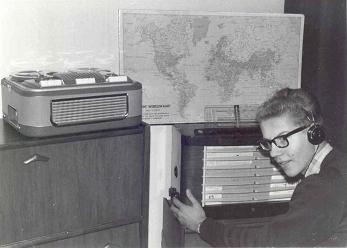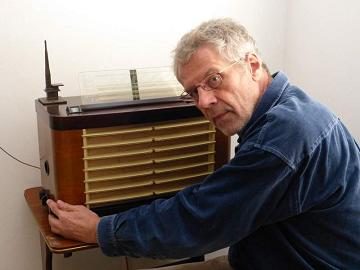
Maarten van Delft, Holland

![]() In
the mid fifties, at the age of 10, I regularly tuned our radio
at home to the shortwave bands. I was fascinated by the exotic
music and the numerous foreign languages I heard. My mother was
not always pleased with my activities and used to say that I was
“milking the radio”.
In
the mid fifties, at the age of 10, I regularly tuned our radio
at home to the shortwave bands. I was fascinated by the exotic
music and the numerous foreign languages I heard. My mother was
not always pleased with my activities and used to say that I was
“milking the radio”.
In the late fifties I once tuned just below the 16 m.b. and heard – heavily distorted – a recorded standard test speech: “Ici Usumbura, Royaume du Ruanda-Urundi……...”. This was then still a united kingdom and a Belgian trust territory, becoming independent in the early sixties as Rwanda and Burundi. Then the name Usumbura was changed to Bujumbura.
Later I understood the distortion I noted with these stations: it was SSB. In 1961 I found out that what I was doing was a hobby called DXing. In 1963 I joined the Radio Communications DX Club which had been founded in 1961. The first few years I continued listening to SSB stations on that radio in our living room and thus trained my hearing. Some people claimed I had ‘BFO ears’!
The set in question was a Philips BX660X (built in 1947) having 13 to 49 metres in 3 well-spread ranges, but alas, no tropical bands! Finally in 1965 I could afford a US Army surplus National HRO-5T receiver together with a BC-221 frequency meter. Much later I used an ICOM R71 for many years and I liked it a lot except for its audio.
I have always stayed true to the voice mode and never wanted to bother with CW or RTTY. I verified voice point-to-point stations from 236 different radio countries. I never did any listening in the maritime and aero bands; only in the 90s a small group of DXers of the ‘RCDXC Newsletter Group’ decided also to count contacts between airports in the aero bands. Sadly, this group ended its activities in 1999 due to a lack of contributions.
The very last standard test speeches I heard in the fixed bands were in 2001 of one or two French Air Force stations using code-word IDs. One was ‘Calorie’, i.e. FAF Narbonne.
Another type of utility stations I liked were the standard frequency and timesignal stations of which I have 35 verified. Finally, where utility DX is concerned, I intensively listened to low-band VHF stations between 30 and 50 MHz during periods of sunspot maxima. This offered worldwide reception of local low-powered stations which normally will cover not more than 50 kms. I also listened to regular broadcasting stations on all ranges and for several years I specialized in FM & TV DX. My best results on FM were: Faeroe Isl., Iceland, Gibraltar, Ceuta, Melilla, Cyprus, Egypt and Israel (the latter 3 on double skip sporadic E layer reflection). My best results on TV were Eastern Canada, Dubai and Zimbabwe, all by multihop F2 layer propagation.
I have travelled far and wide, collecting en route sound material for my DX features on Radio Nederland and Deutschlandfunk (later Deutsche Welle). I also made loggings and collected information for various DX clubs, but I never reported any station for a QSL which I had heard abroad. This I felt was not right. All QSLs I obtained were for receptions made in Holland. After all, DXing is about distance, not proximity.
According to my latest count, I have visited 313 radio stations (broadcasting and point-to-point) in 101 different countries. I often got QSLs on the spot for reports that had remained unanswered. This usually worked well, but it failed 3 times: the Army on Barbados, the Army in Bratislava and the Conoco Oil Co. in Jakarta refused QSLs.
The first QSL I got on the spot was from PTT Copenhagen in 1965. That station was quite ‘black’ back then. My last point-to-point related activity was in Australia in 2013. I checked out 372 Little Bourke Street in Melbourne from which address I received a QSL in 1966 for my reception of the Melbourne Trunk Terminal working Perth. I looked up to the multi-storey building, but I could not find any trace of its former use, so I did not even bother to take a picture. In Canberra I noticed that the antennas of the Naval Communications Station had been removed at Belconnen, a station I visited in 1996. In Sydney I found out that the former OTC transmitting station at Doonside had also been removed, The antennas were still up in 1996, but meanwhile it had been turned into a recreational area for joggers, campers, etc.
I have meanwhile stopped all DX activities. My very sensitive
and quiet ICOM R9000L sadly gave up and 3 attempts by the Dutch
ICOM engineers failed to repair it. My city location in Utrecht
was amazingly quiet, but a couple of years ago I moved to the
small town of Putten and expected the same. No Sir!! I ended up
in a hell of noise!
I tried the following:
- a Wellbrook ALA1530+ active loop antenna (which is less sensitive
to electrical noise)
- an earth connection drilled down to a depth of 42 m
- a mains interference filter
- an RF Systems magnetic transfer device put between my loop and
receiver
- a Neim 1031 noise reduction unit
However, there was no significant improvement so I stopped DXing altogether. But sometimes - in a nostalgic mood - I briefly tune my old Philips and my thoughts wander back to the hay days of HF communications.
Scanning my contributions for Rainer’s virtual museum has given me a lot of pleasure and feelings of great nostalgia for times past. I think Rainer is doing a UFB job maintaining this museum. Mni tnx OM!
August 2014 ![]()

![]() Maarten van Delft
Maarten van Delft
.